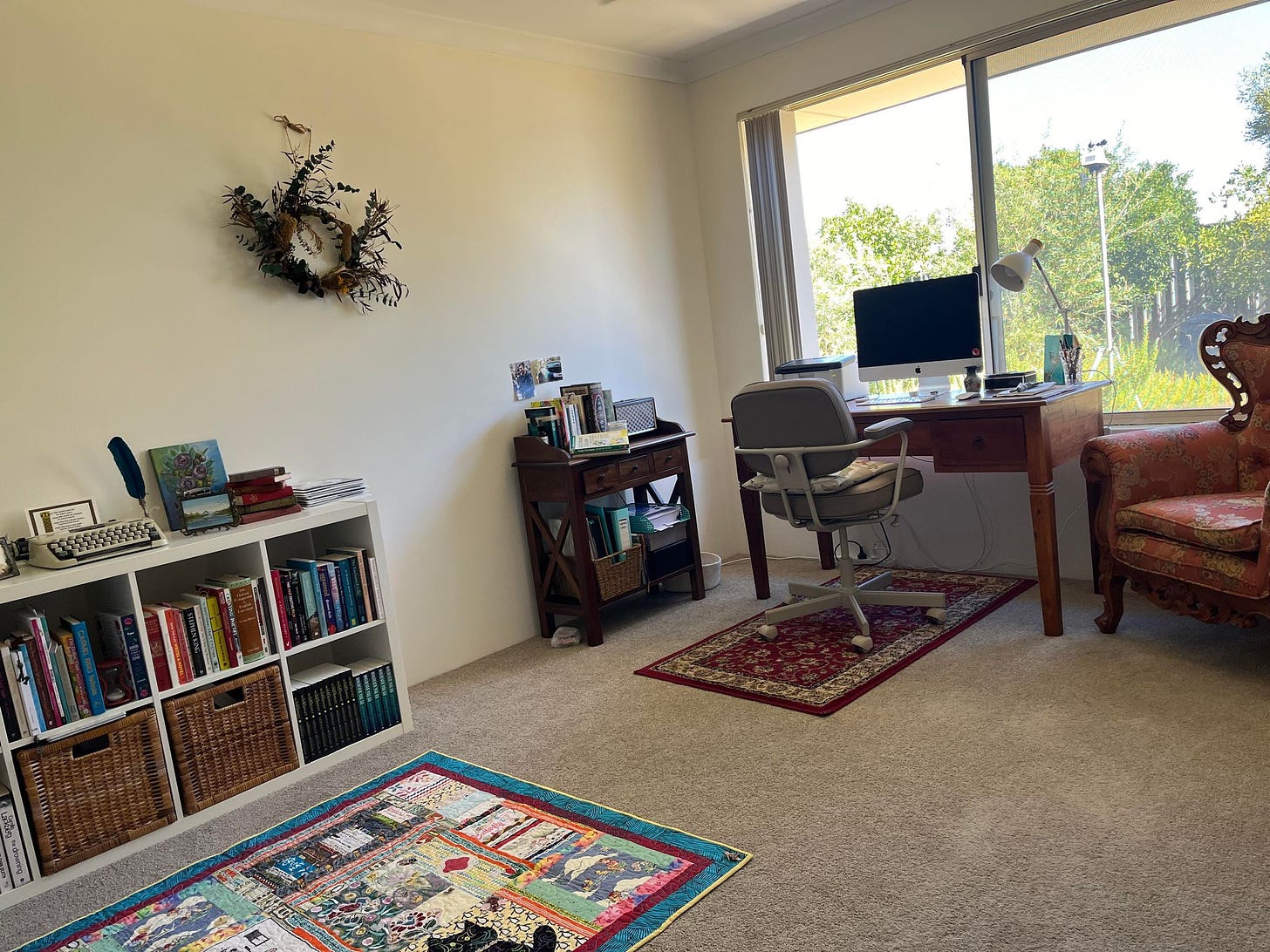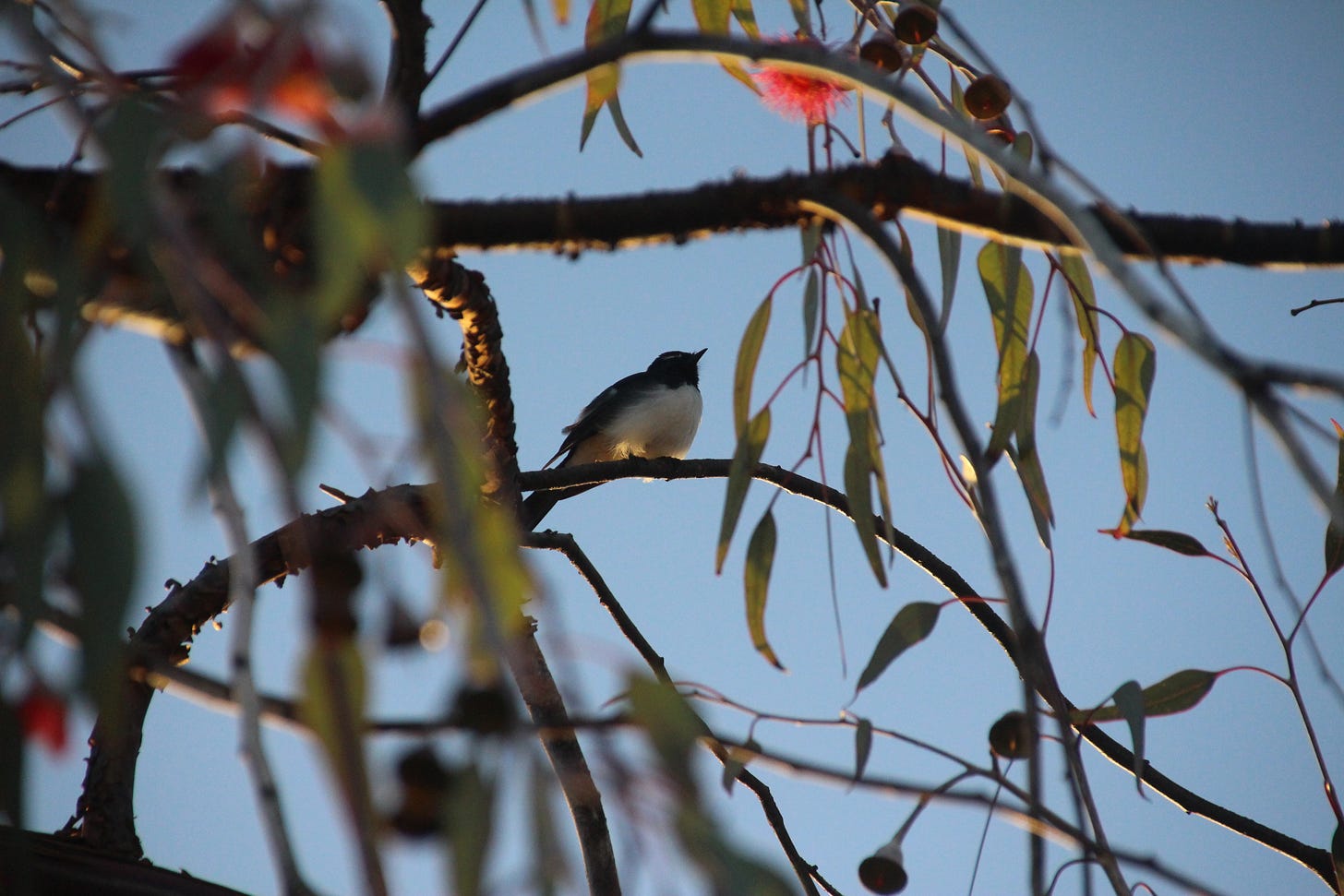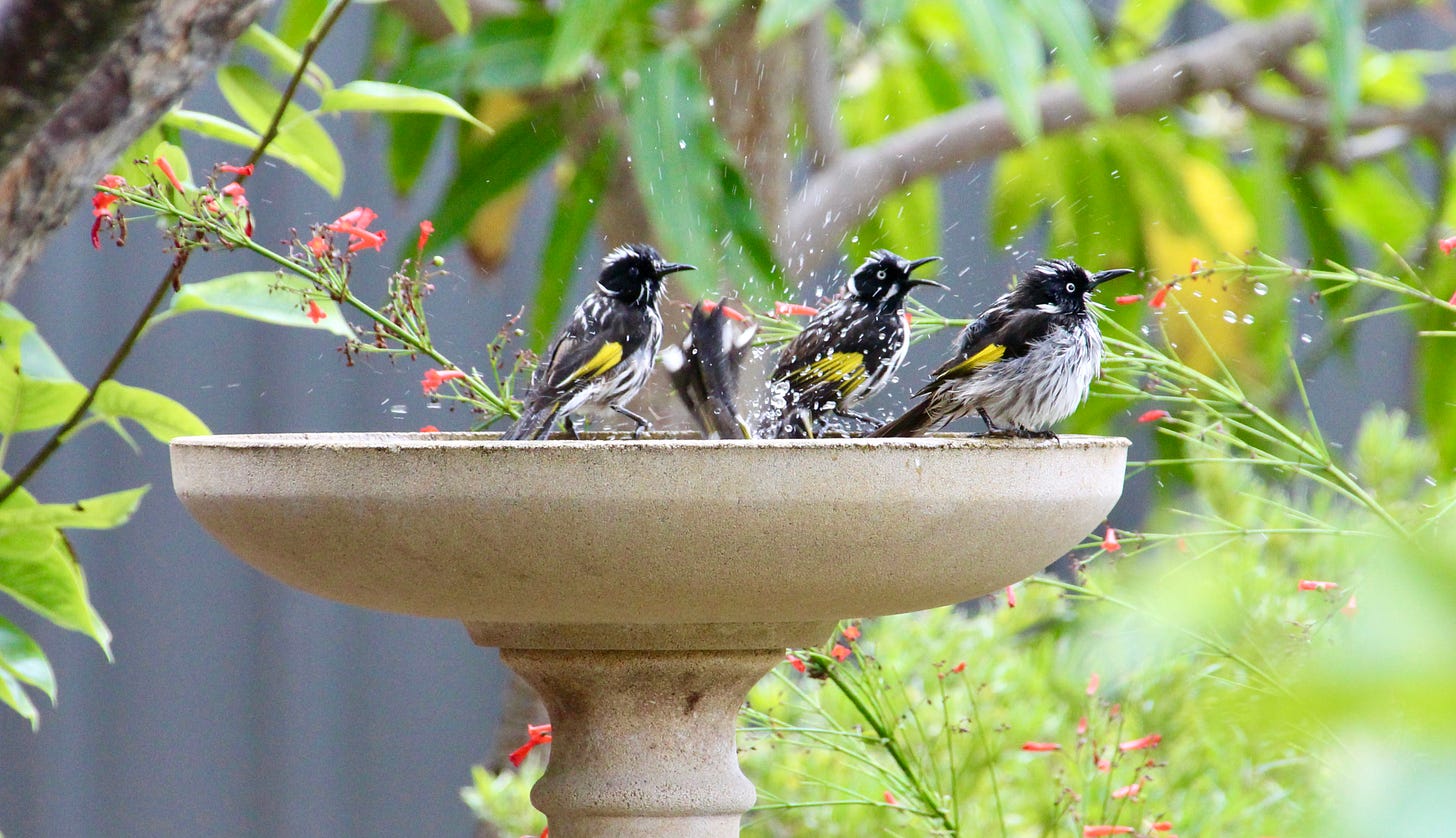Dear Creative Soul,
Last weekend I moved my home office/writing space into an empty nest. This move was inspired in part by Holly Ringland’s book about creativity and overcoming fear, The House That Joy Built; in part by a desire to look out at our back garden, rather than a limestone brick wall. My plan is to add another desk that will become my “analog desk”, an idea borrowed from author Austin Kleon in his book Steal Like an Artist and referenced by Ringland.
“I have two desks in my office—one is “analog” and one is “digital.” The analog desk has nothing but markers, pens, pencils, paper, index cards, and newspaper. Nothing electronic is allowed on that desk … The digital desk has my laptop, my monitor, my scanner, and my drawing tablet. This is where I edit and publish my work.” - Austin Kleon, Steal Like an Artist
I have long known that my Creative Self is not limited to being a writer. Over the years, I have explored drawing, painting, jewellery making, cross-stitiching, mandala drawing, black-out poetry, photography, mosaic-making and more. By moving into a new space, I feel creative possibilities opening up - I feel re-energised about my creative life, whatever form it takes.
This week, I felt inspired to write a short essay about moving house and a morning walk. Writing this way has been calling to me since I started reading A Writer’s Notebook, the popular Substack by
- I have so much gratitude for all her encouragement of writers.***
I have moved house thirteen times in my life. The first time, I was an infant, my mother just eighteen years old. She saved money, coin by coin, week by week, to buy a washing machine for the apartment we lived in. Before that, she has told me, she washed my nappies by hand. I do not remember any of this, of course; before I was a year old, we had moved with my father to a small house up the street from his parents. The acrid smell of privet hedges and a particular owl call, a deep, slow woo-hoo, whisks me back to that time in an instant. My actual memories of the house are shadows: dark rooms, a cocker spaniel in the backyard, my baby sister lying in her cot.
I lock the front door and head downhill; it is 6am and the air is still, a humidity haze hovering over the bushland. The suburban street is in that liminal space between sleep and awake; my footsteps are light, startling a day-dreaming dove. Later, the temperature will reach 40C, but for now the sun’s bite is barely more than a lover’s kiss.
We moved to the outer suburbs, a “nappy valley” area of new builds; we drove down a freeway that stretched to eternity but ended before it reached the mountains. The house was brown brick, surrounded by furrows of browner dirt – I was five and I shared a room with my baby sister. In the tiny dining area, there was a picture on the wall made from red lentils and dried beans – brown, white, maroon; my mother must have spent hours meticulously gluing them into place. I lived in this house until I was twenty-one; the décor changed, the garden blossomed, and the bean picture was replaced with tapestries and textile art displaying my mother’s appliqué and embroidery skills.
There are dried-out seed pods hanging from a Jacaranda, sunset flowers on a Frangipani. On the light poles, a trio of pink-and-grey galahs gossip, pausing the way people do when they are talking about you. I wonder briefly what or whom they are chattering about, but don’t have time to linger.
I did not live with my first husband before our wedding day; after our honeymoon, we rented an old house belonging to my father, furnishing our new life with mismatched cast-offs from other peoples’ lives. Our table was a glass tabletop (from the clearance corner of the local IKEA) placed on a carved blanket box made in China. I still have the blanket box; it is filled with memories – my children’s favourite picture books, photos, drawings.
A crackle of black cockatoos flies overhead. I wonder where they are going, where they have come from. There were hundreds of them living in the old pine plantation behind our street when we moved here. They disappeared when the bulldozers appeared and replaced the birds’ habitat with hundreds of characterless houses.
When my father sold the house, we moved into a new townhouse along a train line and close to the air force base; the rattle and screech of the trains was our morning alarm and we learned not to talk whenever planes roared directly overhead. We did not know that seven years and four moves later, my husband would work at that same air force base, triggering circumstances and experiences that led to an ending.
Magpies carol in a small bush grove, their morning song a melody of joy. The kookaburras love this suburban nook too - in the evening they often break into spontaneous laughter, high above in the Tuart trees. This morning, as I venture onward, a slow kook-kook-kook rises in the air behind me; I smile and walk on.
I was pregnant with my first child when we moved interstate. My mother cried when I told her; three hours’ drive was too far, she told me. I remembered this when, six years later, my husband phoned from East Timor with news that he had been posted across the country, four thousand kilometres away to a place I didn’t want to go. But the first interstate move was our idea – borne of a need to be independent, to try something new. It was a cold house and, when I fed my newborn son in the depths of the night, I wrapped a thick quilt around us to keep warm.
The path lapping the sports centre oval is littered with seed pods and twigs, the remnants of a raucous avian evening feast. I pass other walkers, most with friendly dogs on leads, earbuds wedged in their ears; we smile, say good morning, and keep moving. I left my earbuds at home, as I always do on these walks - I want to hear the music of the earth, the voice of a new day.
A cycle of military-prompted interstate moves began. The houses were small and plain, with boxy kitchens and featureless backyards. We had another child, a boy. Every couple of years we boxed up our lives, and moved from the familiar to the unknown. We told our young sons it was an adventure, but I have never been able to reconcile having my heart on two sides of the country. In one house, unable to hang pictures on the walls, I hung a blue beaded curtain from a doorway, a mosquito net over the bed; the duvet cover was a popular celestial stars and suns pattern that lasted several moves.
A ringneck parrot (aka Twenty Eight) lands on a pillar-and-post fence; beyond the fence the semi-rural block is littered with rusting cars and truck carcasses, and I avert my eyes and banish my judgement. As I pass, the bird peers at me, head cocked to one side, as if asking when my apricot tree will be ready for a visit.
We bought our first home near the beach. I painted the boys’ rooms in bright colours - lime green and purple for the oldest, aqua blue for the youngest; I painted a feature wall in a soft suede-look teal. I bought colourful dishes, painted each of our chipped IKEA chairs a different colour, and created a small garden outside the kitchen window. Perhaps, unconsciously, I used colour to counter the darkness that was increasingly clouding our life. Three years later, when my marriage ended, I repainted the rooms in neutral colours and put the house on the market, more memories into storage.
The air is fragrant with eucalyptus - it’s warm and sharp and lingers in the air as I cross the road and under a branch where a galah hangs regards me while hanging upside down. Another galah drops a half-chewed seed pod millimetres from my head; its pink crest ruffles indignantly when I laugh. An abandoned frisbee is on the kerb; I stoop to pick it up, leave it on a fence post for its owner to find. A willy wagtail watches me, then continues hunting for insects, its fan-like tail quivering as if with anticipation for a tasty bite.
A new love, a new life. Six of us - plus two dogs and two cats - squeezed into a small house for three months, imperfectly blending furniture, routines and expectations. When that house sold, we bought a bigger house a few suburbs away. It was almost twice the size but sometimes it felt too small for all the emotions it held. My husband escaped to the garden, painstakingly reclaiming the dirt that had been supplanted by an oversized pool; one day a crane arrived - I watched the pool hover over our house before it was taken away. We replanted the earth with fruit trees: apricot, mango, pear, lemon, orange, mandarin, apple, pomegranate, avocado; we replanted our lives in this house over the next fifteen years. In both cases, our harvest has been plentiful, if not effortless.
More galahs, foraging on a grassed verge. My skin is damp from the humidity; as I pass houses, I hear showers running, people talking, cars journeying into the day. A magpie lark lands on a letterbox, an invisible crow caws. The sun has found its bite.
Our nest emptied, our birds flying away one-by-one. Dreaming of a different kind of life, we bought an acre of land on a ridge, with 360-degree views of hills. Plans were drawn up for a new house; dreams of country living ended with a pandemic, a housing boom, a car accident. I didn’t see the ute that came around the corner that grey, rainy day we were driving three hours’ south, en route to a life-changing decision. We sold the land. Renovated our kitchen instead. When it was complete, I placed a green hand-painted Turkish bowl on the white granite countertop; three healthy plants under a skylight. The first meal in the new kitchen was a stir-fry and the new stove was a mess.
The excited territorial chatter of a honeyeater greets me when I return home - “Go away!”; inside, a plump black-and-white cat rubs against my legs - “Where have you been?” I have been exploring, I tell her, but I have come home. Later today, I will stand in a queue of fellow coffee-loving employees I don’t yet know; alone in a crowd, I will close my eyes and feel the warm wind on my neck and legs, I will listen to the urban sounds - cars, sirens, birds.
There was a time after the land sale that we imagined moving into a smaller house in the hills. We went to home opens, my hand in a complicated splint; we sized up rooms for furniture, we worked through countless possibilities. Where we live now vs. where we want to live (or rather, how we want to live) plays on our minds still. It is a cycle of settling and unsettling - on the one hand we are exploring ways we can pull back from the hustle and bustle of urban living without physically moving (yet): slow food, slow living, slow travel. And then we see a house online, or my husband “just has a quick check”, and the wondering starts again. The wandering. A cycle of our own creating, a moving and a letting go.
Writing prompt: Write about a time you moved into a new house. How did it feel?










What a lovely piece, Monique ... I was a 'military brat' and I served for 30 years so the constant moves resonate.
The 'where' we want to live and the 'how'. What a great question in life ... I think the 'how' wins out - we are trying to live in a spirit that suits us; somehow we manage to be 'us' wherever we end up ... settled (for now) with the land and the growing seasons and nature on the doorstep, but craving water and hills ... and some more roaming.
And an analogue desk ... yes, yes! What a great idea.
Hi Monique - I can so relate to where you're living and the slowing down and the desire for less - but for more at the same time - less hustle and bustle, more space, more air to breathe. The housing market has messed with a lot of people's plans, but it also gives time to think through what is really wanted, what is necessary, what makes for a "home". I hope you find your happy place - we live in the SW of the state and I don't think I could ever live in the city again - even though my adult kids think it's the place to be.....